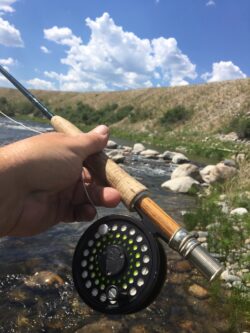Fishermen love their rods! I had a buddy named Dave, who’s basement had hundreds of rods on display. He also broke more rods than anyone I ever saw.
Before you select a rod, do some homework. Picking up a rod and wiggling it tells you nothing. Consider what you want the rod for. Not all rods are equal.
Let us say you are buying a new rod. Ask these questions first.
What kind and size fish will you go after? Sure, we all plan to catch Moby Dick, but the reality is different. A rod for Halibut is certainly going to be heavier than an Ultra Lite spinning rod. To use a lighter rod is more sporting but will take longer to land the fish. Lighter line breaks easier. You want the rod to be able to hold up to your needs.
How Big of a rod do you need? Size matters. Longer is not always better. Fly rods, surf rods, and Spey rods can be over 10 feet long. Small spinning rods, for ice fishing can be less than a couple feet. Most average fly rods are 9 foot. Most spinning rods are 8-9 foot. Bay and boat rods are closer to 6 feet. Generally, the longer rods can be better for longer casts and lighter tips, Shorter rods are harder to cast but perfect for just dropping the rigs into the deep water. A great drag is more important when fighting a Big Fish, than a beefy rod.
How big is your reel? What ever reel you select, get one with a great drag. Almost any reel will fit on any rod but, get a rod that fits the reel you plan to use. Its better to be slightly bigger than smaller in a reel size. The rod can work well if the fulcrum, balance point, is slightly back that just in front of the handle. Remember there will also be weight at the opposite end where heavy fly lines or mono with lures/bait is attached. Make sure the rod has a sturdy reel seat.
What size line will you be using? Fly lines come in many weights and sizes. So does braid, mono, and other lines. Use the rod for the line you plan to buy. Its better to be a tad heavier than lighter. You want the rod to work, flex, and bend.
How far are your average casts? If your average cast is 20 feet, you don’t need a rod that will cast a mile. Gear up for the fishing you will do. You can increase distance in other ways than the rod. Small weight fly rods in 2-4 weights, are great for small creeks and waters, not big rivers, and lakes.
Where do you store or carry the rod? Will the rod travel in one piece or sections? Longer rods are at greater risk for breakage than take down rods. Rods that separate into sections will fit nicely into a smaller tube. Most rods break at the tips, so protect that section the most.
What handle do you prefer? Shape, size, and material are factors. My guess is that cork handles will soon be a thing of the past. Synthetic handles will be taking over. These new handles are light, durable, and custom shaped. Fly rod handles come in a Cigar shape, half, and full well shapes. The “wells” are better for bigger, heavier rods. I prefer longer handles on spinning and boat rods.
Will the rod cast for you? Take your reel with you to a store and test the rod out. Carry a small casting lure, with no hooks, and give the rod a test drive. Most salesman are flexible and will offer additional info and tips with you. Test the reel seat for strength.
Purchase a rod that you enjoy and appreciate!
Montana Grant